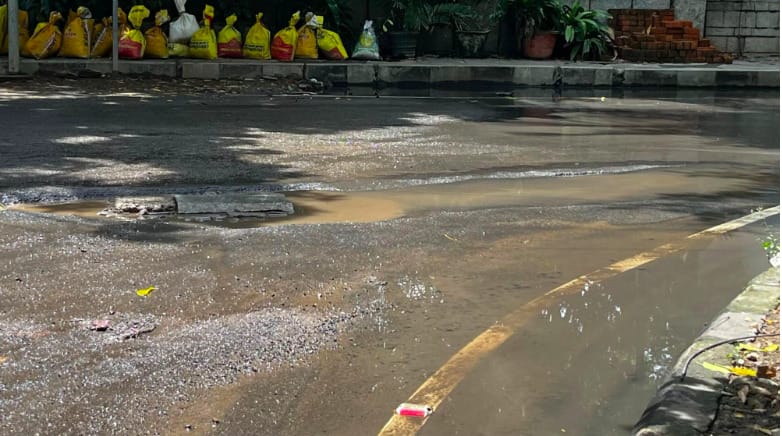Chennai receives the majority of its annual rainfall during the monsoon season, from October to December. While the monsoon brings relief from the heat, it also poses various challenges for motorists.
Rainy weather makes driving dangerous. Visibility is poor, and roads are slippery, meaning vehicles take longer to stop than on dry road surfaces. This can lead to road crashes and even fatal incidents. These risks result from two primary factors: road conditions itself, and drivers not taking adequate safety precautions.
Either way, it is the motorists and their families who bear the consequences of an injury or fatality.
Read more: Road accidents in Chennai and what can be done to prevent them
State of Chennai roads during monsoons
Surface water logging is perhaps the most apparent hazard that drivers are likely to encounter on a rainy day. For example, in June 2023, a single night of downpour had significant consequences in Chennai city where water accumulated in nearly 80 locations demanding the deployment of police and disaster response personnel.
Surface water logging can conceal existing potholes, and even wash away considerable chunks of road surfaces, creating brand-new hazards. Add to this, the hazards from fallen trees or cut powerlines. And of course, the perils from these are to both vehicle and human life. An injury or a seized engine can carry significant economic fallout as well.
Dangers of speeding on Chennai roads during rains
Driving fast during or after rains can lead to hydroplaning. To simplify this, at elevated speeds, your vehicle is more likely to lose traction and skid on water that accumulates between the road’s surface and the tires. As a result, you can easily lose control of your vehicle.
Even if you don’t hydroplane, bringing the vehicle to a complete halt takes longer in wet conditions as it diminishes the efficiency of your vehicle’s braking system. Add to this the fact that the faster you go, the more distance you need to stop safely. You can see then why rain and speed don’t mix well.
Additional risks and concerns this monsoon
Delays in completing civic work lead to damaged roads and cause frustration for citizens, especially during rainy weather. Even a light shower can turn the entire road muddy. For instance, in neighbourhoods such as Madipakkam, Manapakkam, and Mugalivakkam, the delays in completing metro water infrastructure have caused significant disruptions on the roads and have created considerable challenges for residents when it comes to their daily commute. These road work delays are not just inconvenient; they also slow down emergency services in case of a mishap.
Another critical concern during heavy rainfall is the condition of the city’s trees. Many of these trees are old, large, and require maintenance. When they aren’t trimmed or pruned before the onset of monsoon, they become vulnerable to breakage of branches or, in the worst-case scenario, uprooting.
A near-fatal incident involving a two-wheeler commuter highlighted this danger during a heavy rainstorm in 2021. Furthermore, falling trees or branches can block roads, disrupt traffic flow, and damage vehicles.
Read more: North Chennai roads turn into an obstacle course for commuters
Tips and precautions for motorists in Chennai
With the monsoon season approaching, here are some precautions each of us should take for a safe driving experience:
- Weather awareness: Stay informed about weather forecasts and plan your journeys accordingly.
- Optimal vehicle condition: One of the foundational aspects of road safety is ensuring that your vehicle is in optimal condition before embarking on your journey. Check tire tread for grip and maintain proper inflation. Inspect brake pads, and brake fluid for efficient stopping. Test all lights (headlights, indicator lights), clean your windshield and make sure that windshield wipers work. Clean your helmet visor for optimal visibility in rainy conditions.
- Tackling waterlogged roads: Keep your vehicle in the middle of your lane, avoiding the edges where water tends to collect. Drive slowly and keep the engine revved. This prevents water from entering the engine and leaving you stranded on the road.
- Watch out for hydroplaning: If you sense your vehicle slipping on the wet road, stay calm. Gradually release the accelerator and gently steer in your desired direction to regain control.
- Brake smoothly: Apply the brakes gently and progressively. Sudden or hard braking can cause your vehicle to skid on wet surfaces.
- Slow down: Reduce your driving speed well below the posted speed limit as the stopping distance of your vehicle increases on wet and slippery roads. This not only allows you to maintain better control of your vehicle but also provides you with more time to react to unexpected situations on the road.
Government’s role in ensuring Chennai’s monsoon preparedness
In preparation for the monsoon’s arrival, municipal authorities must take proactive steps to safeguard citizens such as pruning trees; ensuring roads are relaid with appropriate slopes to minimise waterlogging; completing any continuing civic works; ensuring the stormwater drain systems are clear and operable; post cautionary signs where needed; and improve awareness of road users on how to safely navigate the roads during the monsoons.
[This story was first published on the blogs of Citizen Consumer and Civic Action Group and has been republished with permission. The original post can be found here.]
